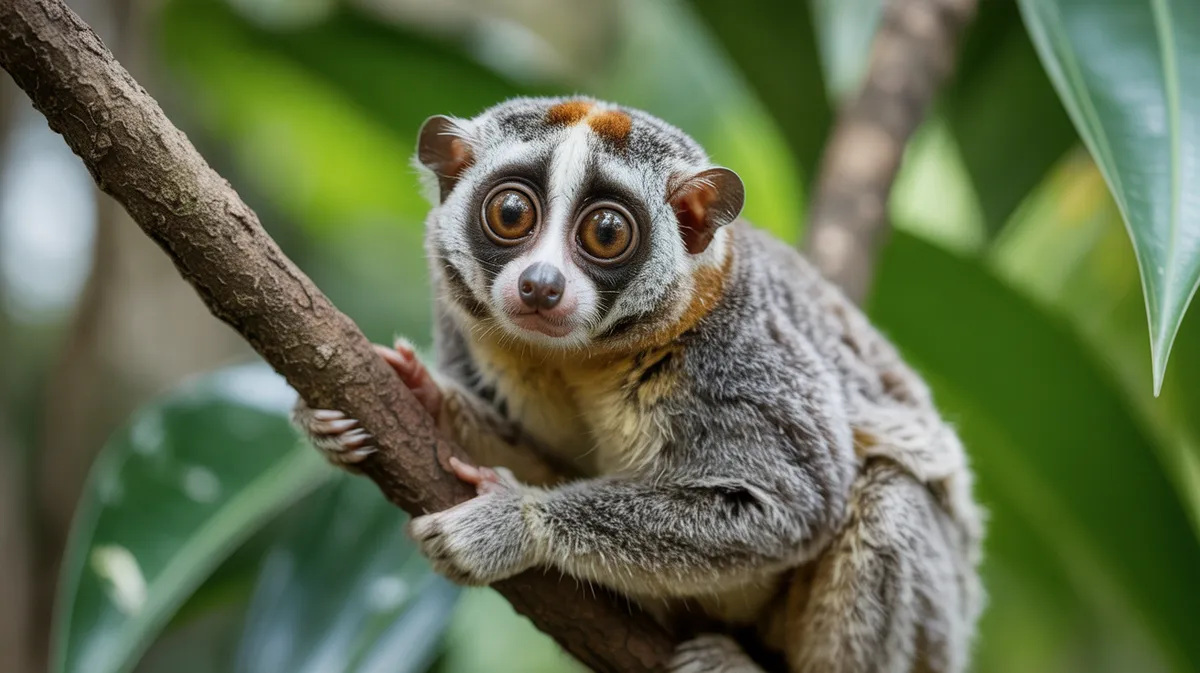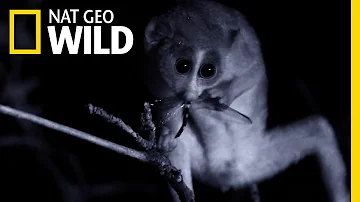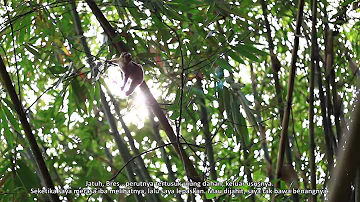
Sunda Slow Loris
Nycticebus coucang

Meet the Sunda Slow Loris
The Sunda slow loris is a small, nocturnal primate native to Southeast Asia's rainforests. It is recognized by its large, round eyes, soft dense fur, and a distinctive facial mask. This arboreal animal moves slowly and deliberately through the trees, relying on its strong grip and stealth to avoid predators. The Sunda slow loris is unique among primates for its toxic bite, which it uses for defense and sometimes for hunting small prey. Its populations are threatened by habitat loss and illegal wildlife trade for the pet and traditional medicine markets.
Classification
Mammal
Habitat
Tropical rainforests
Diet
Omnivore
Lifespan
15-20 years
Conservation
Endangered
Weight
600-685 grams
📖Fascinating Facts
Nocturnal Lifestyle
Sunda slow lorises are strictly nocturnal, emerging at night to forage for food and moving slowly through the forest canopy.
Venomous Bite
They possess a gland near their elbows that produces a toxin; when licked and mixed with their bite, it becomes a potent defense mechanism.
Arboreal Adaptations
With a strong grip and specialized hands and feet, Sunda slow lorises are expertly adapted for life in the trees, rarely descending to the ground.
📋Detailed Description
The Sunda slow loris (Nycticebus coucang) is a medium-sized strepsirrhine primate, measuring 27–38 cm in length and weighing between 599–685 grams, with females typically slightly larger than males. Its dense, woolly fur varies from light brown to greyish, with a distinctive dark dorsal stripe running along the back and a contrasting facial mask encircling its large, forward-facing eyes—an adaptation for nocturnal vision. The head is round with small, nearly hidden ears, and the vestigial tail is barely visible. Its hands and feet are highly specialized, featuring a strong grip and a reduced index finger, allowing for precise, slow movement through the forest canopy. The Sunda slow loris is primarily arboreal and strictly nocturnal, spending daylight hours curled up in dense foliage or tree hollows. It possesses a unique brachial gland near the elbow, which secretes a toxin that, when mixed with saliva, delivers a venomous bite—an extremely rare trait among mammals. Social structure is generally solitary or loosely associated, with overlapping home ranges but little direct interaction outside of mating or maternal care. Vocalizations are limited, but scent-marking and ultrasonic calls are important for communication. Its omnivorous diet includes tree gum, nectar, fruit, insects, and small vertebrates, with a specialized toothcomb for gouging bark to access gum. The species plays a role in pollination and seed dispersal within its ecosystem.
💡 Did you know?
The bite of the Sunda slow loris can cause severe allergic reactions in humans, sometimes leading to anaphylactic shock.
🔬Research & Sources
Wikipedia Summary
The Sunda slow loris, or greater slow loris, is a strepsirrhine primate and a species of slow loris native to Indonesia, West Malaysia, southern Thailand and Singapore. It measures 27 to 38 cm from head to tail and weighs between 599 and 685 g. Like other slow lorises, it has a wet nose (rhinarium), a round head, small ears hidden in thick fur, a flat face, large eyes and a vestigial tail.
Last Modified: 5/25/2025
🎭Behavior & Social Structure
Sunda slow lorises are predominantly solitary, with individuals maintaining overlapping territories marked by urine and glandular secretions. They are slow and deliberate movers, using a unique hand-over-hand locomotion to minimize detection by predators and prey. Foraging occurs at night, with individuals traveling up to 2 km in a single night to locate food sources. Their diet is highly varied: they use their toothcomb to gouge tree bark for gum and sap, lap up nectar (sometimes acting as pollinators), and opportunistically hunt insects, bird eggs, and small vertebrates. Feeding bouts are interspersed with long periods of rest, and they exhibit cryptic behavior, freezing when threatened. Social interactions are rare but can include grooming, play, and vocalizations—often ultrasonic—between mothers and offspring or during mating. They exhibit strong site fidelity, returning to the same sleeping sites, which are often shared by mothers and dependent young.
👶Reproduction & Life Cycle
The Sunda slow loris is polygynandrous, with both males and females mating with multiple partners. Breeding can occur year-round, but peaks are observed in some regions, often linked to food availability. Females have a gestation period of approximately 185 days, typically giving birth to a single offspring, though twins are occasionally recorded. Neonates are altricial, born with eyes open but unable to cling, so mothers park their infants on branches while foraging, returning frequently to nurse and groom them. Parental care is provided exclusively by the mother; weaning occurs at around 6–7 months, and juveniles remain with the mother for up to 12 months before dispersing. Sexual maturity is reached at about 18–24 months. The slow loris has a relatively low reproductive rate, contributing to its vulnerability.
🛡️Adaptations & Survival
Key adaptations include large, forward-facing eyes with a reflective tapetum lucidum for enhanced night vision, and a reduced index finger for a powerful grip. The toothcomb (a row of forward-tilted lower incisors) is used for grooming and gouging tree bark to access gum. The brachial gland produces a secretion that, when mixed with saliva, becomes a potent toxin capable of causing severe allergic reactions in predators and humans. This toxin is used in defense and possibly in intraspecific competition. Their slow, deliberate locomotion and cryptic coloration help them avoid detection by predators such as snakes, raptors, and civets. Additionally, their metabolic rate is unusually low for a primate of their size, which may help them survive periods of food scarcity.
🎨Cultural Significance
In local folklore across Southeast Asia, slow lorises are often associated with mystical or supernatural powers. Some traditional beliefs hold that their venomous bite or body parts can ward off evil spirits or cure diseases, fueling their exploitation in traditional medicine. In popular culture, their 'cute' appearance has led to demand as exotic pets, especially following viral internet videos, which has further threatened wild populations. Conservation organizations have worked to dispel myths and educate the public about the cruelty and illegality of the pet trade.
🔬Recent Research & Discoveries
Recent research has focused on the chemical composition and function of the slow loris's brachial gland toxin, revealing complex proteins similar to allergens found in cat dander. Studies using radio telemetry and camera traps have improved understanding of their home range, habitat use, and nocturnal activity patterns. Genetic analyses have clarified species boundaries within the Nycticebus genus, leading to the recognition of cryptic species and highlighting the need for region-specific conservation strategies. Ongoing research is examining the impacts of habitat fragmentation and the effectiveness of reintroduction programs for rescued individuals. Conservationists are also studying the role of slow lorises in forest ecology, particularly their contributions to pollination and seed dispersal.
🎥Wildlife Videos

Slow Loris - 5 Minute Documentary
Venture into the enchanting and enigmatic world of the slow loris with a mesmerizing five-minute documentary that unveils the ...
Five Minute Documentaries

Sunda Slow Loris - Leo The Wildlife Ranger | #shorts
When a Sunda slow loris lands in the garden, the Junior Rangers quickly learn that they have to return it to the wild. Will they ...
Giggle Mug

A Loris in the Night | Wild Sri Lanka
About National Geographic Wild: National Geographic Wild is a place for all things animals and for animal-lovers alike. Take a ...
Nat Geo Animals

Wild Vietnam: Pangolins, Primates, and the Land of Mountain Forests (Full Episode) | Nat Geo Wild
Travel to Vietnam's mountains to visit crocodile lizards, endangered pangolins, and rare primates: the golden-headed langurs of ...
Nat Geo Animals

Slow Loris Little Fireface Project Documentary by Muhammad Taufik
In 2013, MSc student Muhammad Taufik stayed with our Little Fireface Project in West Java, to document the plight of the slow ...
Little Fireface Project

Bengal slow loris।।বাংলার লজ্জাবতী।।
Bengalslowloris #slowloris #wildlife #documentary #biodiversity #লজ্জাবতীবানর The Bengal slow loris (Nycticebus ...
EXPLORE WITH TOFAYEL
🌍Habitat Information
The Sunda Slow Loris typically inhabits Tropical rainforests environments. Sunda Slow Loriss have adapted to their environments with specialized features and behaviors.
Primary Habitat:
Tropical rainforests
More detailed habitat information will be available soon.
🛡️Conservation Status
The Sunda Slow Loris is currently classified as Endangered. Conservation efforts are crucial for preserving this species for future generations.
Common Threats:
- 🏠Habitat loss and fragmentation
- 🌡️Climate change impacts
- 🎯Hunting and poaching
- 🏭Human-wildlife conflict
⚠️Threats & Conservation Challenges
The Sunda slow loris faces severe threats from habitat loss due to deforestation, agricultural expansion, and urban development throughout its range. Illegal wildlife trade is a critical issue: they are captured for the exotic pet market and for use in traditional medicine, where their body parts are erroneously believed to cure various ailments. Capture often involves the cruel removal of their teeth, leading to high mortality. Population declines are exacerbated by their low reproductive rate and specialized habitat requirements. Fragmentation of forest habitat isolates populations, reducing genetic diversity and increasing vulnerability to local extinction. The species is listed as 'Endangered' by the IUCN and is included in CITES Appendix I, prohibiting international trade.
🔬Scientific Classification
Scientific Name
Nycticebus coucang
Classification Hierarchy
🔍 About Taxonomic Classification
Taxonomic classification is a hierarchical system used by scientists to classify and organize living organisms based on shared characteristics and evolutionary relationships.
The system moves from broad categories (Kingdom) to increasingly specific ones, with each animal's scientific name typically consisting of its Genus and species.
📝Community Notes
Share your observations and insights about the Sunda Slow Loris with our community of wildlife enthusiasts.
Join Our Community
Sign in to share your observations and connect with fellow wildlife enthusiasts.
Sign In to ContributeNo community notes yet
Be the first to share your observations about the Sunda Slow Loris!
Explore Sunda Slow Loris
Select a tab above to learn more about this amazing animal.
📸Photo Gallery
No photos available for this animal yet.
🌟Discover More Wildlife
Continue your journey of discovery with more fascinating animals from our database
